Quick Breads
Quick Breads
For mouth-watering breads that don’t require a lot of time, turn to quick breads. By using baking powder, baking soda, steam, or air instead of yeast to leaven dough. An advantage of quick breads is their ability to be prepared quickly and reliably, without requiring time-consuming skilled labor and the climate control needed for traditional yeast breads. Quick breads include banana bread, beer bread, biscuits, cornbread, cookies, muffins, cakes, pancakes, brownies, scones, and soda bread.
Almost all quick breads have the same basic ingredients: Flour, leavening, eggs, fat (butter, margarine, shortening, or oil) and a liquid such as milk. Ingredients beyond these basics are added for variations of flavor and texture. The type of bread produced varies based predominantly on the method of mixing, the major flavoring, and the ratio of liquid in the batter. Some batters are thin enough to pour and others are thick enough to mold into lumps.
There are four main types of quick bread batter:
Pour Batters: Such as pancake batter, have a liquid to dry ration of about 1:1 and so pours in a steady stream – also called a “low-ratio” baked good.
Drop Batters: Such as cornbread and muffin batters, have a liquid to dry ratio of about 1:2.
Soft Doughs: Such as many chocolate chip cookie doughs, have a liquid to dry ratio of about 1:3. Soft doughs stick significantly to work surfaces.
Stiff Doughs: Such as pie crust and sugar cookie doughs, have a liquid to dry ratio of 1:8. Stiff doughs are easy to work in that they only minimally stick to work surfaces, including tools and hands – also called “high-ratio” baked goods.
Preparing a quick bread generally involves two mixing containers. On contains all dry ingredients (including chemical leavening agents or agent) and one contains all wet ingredients (possibly including liquid ingredients that are slightly acidic in order to initiate the leavening process). In some variations, the dry ingredients are in a bowl and the wet ingredients are heated sauces in a saucepan off-heat and cooled.
During the chemical leavening process, agents (one or more food-grade chemicals – usually a weak acid and a weak base) are added into the dough during mixing. These agents undergo a chemical reaction to produce carbon dioxide, which increases the baked good’s volume and produces a porous structure and lighter texture. Yeast breads often take hours to rise, and the resulting baked good’s texture can vary greatly based on external factors such as temperature and humidity. By contrast, breads made with chemical leavening agents are relatively uniform, reliable, and quick. Usually, the resulting baked good is softer and lighter than traditional yeast breads.
Chemical leavening agents include a weak base, such as baking soda (sodium bicarbonate) plus a weak acid, such as cream of tartar, lemon juice, or cultured buttermilk, to create an acid-base reaction that releases carbon dioxide. Quick bread leavened specifically with baking soda is often called “soda bread.” Baking powder contains both an acid and a base in dry powdered form, and simply needs a liquid medium in which to react. Other alternative leavening agents are egg whites mechanically beaten to form stiff peaks, as in the case of many waffle recipes, or steam, in the case of cream puffs.
There are three basic methods for making quick breads, which may combine the “rise” of the chemical leavener with advantageous “lift” from other ingredients.
The Stirring Method: Also known as the quick-bread method, blending method, or muffin method is used for pancakes, muffins, corn bread, dumplings, and fritters. This method calls for measurement of dry and wet ingredients separately, then quickly mixing the two. Often the wet ingredients include beaten eggs, which have trapped air that helps the product to rise. In these recipes, the fats are liquid, such as cooking oil. Using mixing is done using a tool with a wide head such as a spoon or spatula to prevent the dough from becoming over-beaten, which would break down the egg’s lift.
The Creaming Method: Frequently used for cake batters. The butter and sugar are “creamed” or beaten together until smooth and fluffy. Eggs and liquid flavorings are mixed in, and finally dry and liquid ingredients are added in. The creaming method combines rise gained from air bubbles in the creamed butter with the rise from the chemical leaveners. Gentle folding in of the final ingredients avoids destroying these air pockets.
The Shortening Method: Also known as the biscuit method, is used for biscuits and scones. This method cuts solid fat (whether lard, butter, or vegetable shortening) into flour and other dry ingredients using a food processor, pastry blender, or two hand-held forks. The layering from this process gives rise and adds flakiness as the fold of fat melts during baking. This technique is said to produce “shortened” cakes and breads, regardless of whether or not the chosen fat is vegetable shortening.
Quick bread originated in the United States at the end of the 18th century. Before the creation of quick bread, baked goods were leavened with either yeast or by mixing dough with eggs. The discovery of chemical leavening agents and their widespread military, commercial, and home utilization in the United States dates back to 1846 with the introduction of commercial baking soda in New York by Church and Dwight of “Arm & Hammer” fame. This development was extended in 1956 by the introduction of commercial baking powder in Massachusetts, although the best known form of baking powder is “Calumet”, which was first introduced in West Hammond and Hammond, Indiana (later Calumet City, Illinois) in 1889. Both forms of food-grade chemical leaveners are still being produced under their original names.
During the American Civil War (1861-1865) the demand for portable and quickly made food was high, while skilled labor for traditional bread making was scarce. This encouraged the adoption of bread, which was rapidly made and leavened with baking soda, instead of yeast. The shortage of chemical leaveners in the American South during the Civil War contributed to a food crisis.
As the Industrial Revolution accelerated, the marketing of mass-produced prepackaged foods was eased by the use of chemical leaveners, which could produce consistent products regardless of variations in source ingredients, time of year, geographical location, weather conditions, and many other factors that could cause problems with environmentally sensitive, temperamental yeast formulations. These factors were traded off against the loss of traditional yeast flavor, nutrition, and texture.
www.tinynewyorkkitchen.com
“Work With What You Got!”
© Victoria Hart Glavin Tiny New York Kitchen © 2016 All Rights Reserved
English Stew (1860)
English Stew (1860)
English stew is the name given to the following excellent preparation of cold meat. Cut the meat in slices, pepper, salt, and flour them, and lay them in a dish. Take a few pickles of any kind, or a small quantity of pickled cabbage, and sprinkle over the meat. Then take a tea-cup half full of water; add to it a small quantity of the vinegar belonging to the pickles, a small quantity of catsup, if approved of, and any gravy that may be set for use. Stir all together and pour it over the meat. Set the meat before the fire with a tin behind it, or put it in a Dutch oven, or in the oven of the kitchen range, as may be most convenient, for about half an hour before dinner-time. This is a cheap, simple way of dressing cold meat.
“Work With What You Got!”
© Victoria Hart Glavin Tiny New York Kitchen © 2016 All Rights Reserved
Buttered Cabbage
Buttered Cabbage
Civil War deprivations did not stop women from sharing recipes (receipts) with one another. This recipe for Buttered Cabbage was published in Godey’s Lady’s Book in 1862.
“Boil the cabbage with a quantity of onions, then chop them together, season with pepper and salt, and fry them in butter. It is a rather homely, but savory dish, and frequently used either with fried sausages laid over it or as an accompaniment to roast beef, and forms part of bubble and squeak.”
“Work With What You Got!”
© Victoria Hart Glavin Tiny New York Kitchen © 2016 All Rights Reserved
Constitution Week – Foods of Our Forefathers Part IV
 Constitution Week – Foods of Our Forefathers Part IV
Constitution Week – Foods of Our Forefathers Part IV
The longer winters in New England produced a diet somewhat different from that in Virginia. Not as many varieties of fruits and vegetables grew as in the South, and emphasis was put on those which would store well or which could be converted to something stable through drying, salting, or pickling. The staple grain in the early days was rye, in addition to the new grain, Indian corn. A common bread was called “Rye’ n Injun,” and was baked from a yeast dough of rye, cornmeal, and molasses. Wheat did not grow well in the harsh climate, and the small amount of wheat flour available was used “for best,” as was the refined sugar.
Sweet potatoes and other root vegetables and cabbages were major items on the menu. All cooking was done in cavernous fireplaces, either in kettles or on spits. The cooking range, although invented by Count Rumford in the late 1700’s, didn’t become popular until the Civil War era. The New England boiled dinner of corned beef, potatoes, cabbage and whatever else was available, was a natural outgrowth of fireplace cooking. Beans baked in a pot set in the coals also fit the New England style of cooking and the available found supply.
Although mutton had been the main meat supply in England, pigs were more attractive than sheep in the new land. For one thing, sheep usually had only one lamb at a time, while a litter of pigs a dozen strong was not uncommon. Also, pigs could forage for themselves at an earlier age than sheep, and thrived on the vegetation in forest and field.
Cattle were kept largely for milk and cheese, and although they were scarce at first, they reproduced prolifically in the Northeast. In fact, the Reverend John Cotton once remarked “milk and ministers were the only things cheap in New England.”
In other parts of the country, settlers found more new foods and used them in new ways. In Louisiana, for example, French settlers adapted their old world recipes to accommodate such new foods as tomatoes, okra, crayfish, red snapper, catfish and, of course, corn. The climate was amenable to growing fruits and vegetables year ‘round, making a varied diet easy to get – even if it didn’t taste like home.
In the Charleston and Savannah areas, rice cultivation began very early, in 1694, and soon became a major business. Much of the rice was exported. Oranges were also grown in the Charleston area.
In the Southwest, the Spanish had developed a cuisine all their own, as they moved north from Mexico and Latin America. New varieties of beans, plus the ever-present corn, were cooked with traditional Spanish spices plus something unknown in Spain – hot peppers. With the continual warm weather were also possible, at least where water was available, and there was little emphasis on preservation. In the more arid areas, however, variety was as limited as during winter in New England. Beans, corn and squash were the order of the day.
As time went on, Americans moved west, and the frontiersmen had an entirely new set of problems to meet. Trappers and explorers traveled light, and that usually meant living primarily off the land. Many subsisted almost exclusively on meat, killing bear, venison and small game as they went. One of Pierre LeSeur’s men wrote in his journal of consuming about 10 pounds of buffalo meat each day, plus four bowls of broth. While buffalo meat apparently took some getting used to, this particular explorer wrote that “it made us quite fat, and none was sick.”
One “recipe” called for bear steak fried in tallow and covered with whisky – meat and drink in one meal! Pemmican, made from dried meat, fat and berries ground together, was travelling food. Beef and buffalo cut into strips and dried in the sun was called “jerky,” and kept well, even though it was tough chewing!
Bread was almost unknown, but occasionally a hardtack or ship biscuit could be obtained at a trading post.
The frontiersmen, including migrating settlers, also found the edible wild plants to be helpful sources of nutrients missing from the dried and salted staples. These included such things as dandelions, polk sprouts, sassafras, grapes and various nuts and berries. When they found a place to stay for a season, corn could be planted by simply making a hole with a pointed stick or ax, dropping several kernels into the rich soil – and a crop would grow; plowing simply wasn’t necessary.
To Be Continued…









